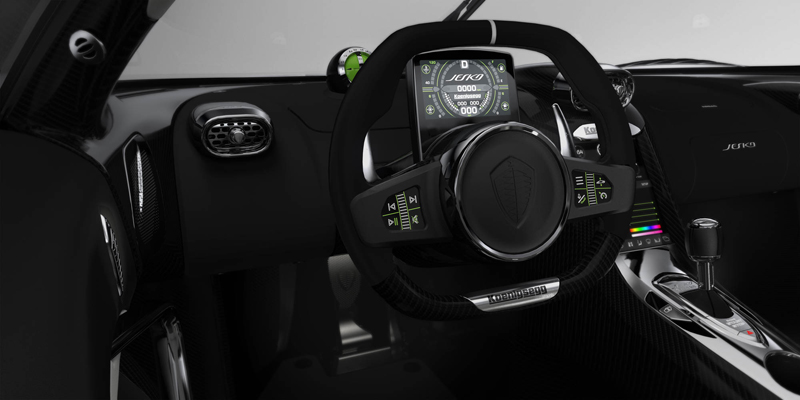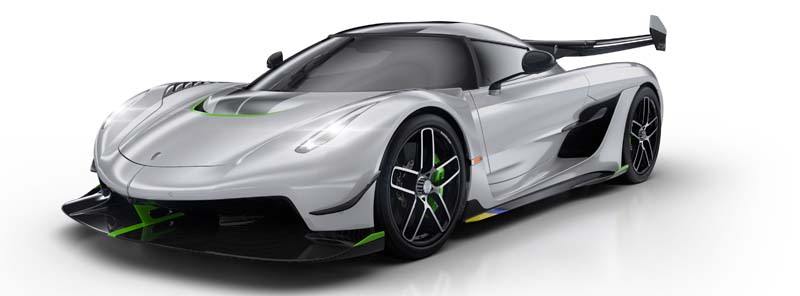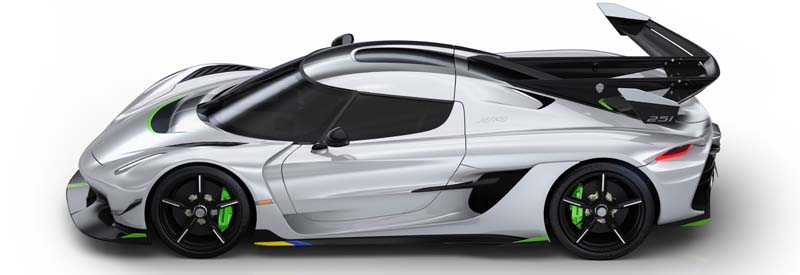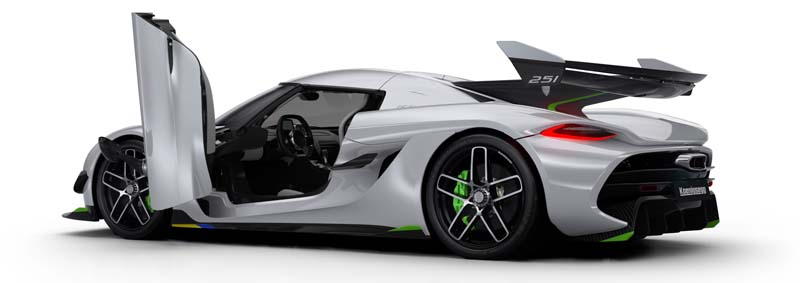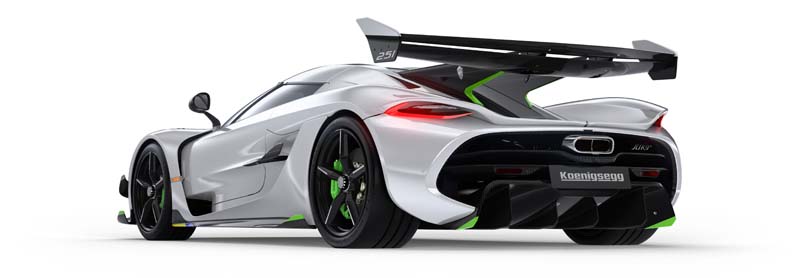The Koenigsegg 1600 hp Jesko 2019
GENEVA - March 5, 2019 - Koenigsegg has unveiled an all-new megacar - the Koenigsegg Jesko - at the 2019 Geneva International Motor Show. Jesko inherits the mantle left by the Agera RS as the leading trackfocused, road-legal car for those looking for the ultimate in vehicle performance.
Jesko is named for Jesko von Koenigsegg, the father of company Founder and CEO, Christian von Koenigsegg. Jesko von Koenigsegg was a key presence at Koenigsegg Automotive during its formative years. His considerable business acumen helped steer the company through many early challenges. Now retired and in his 80’s, Jesko von Koenigsegg and his wife, Brita, were on-hand at the 2019 Geneva Motor Show to see his namesake vehicle introduced to the world. The Koenigsegg 1600 hp Jesko 2019 : A More Powerful Twin-Turbo V8Jesko is powered by a re-designed twin-turbo V8 engine with a new 180-degree flat-plane crankshaft, new intake, bigger turbos with air injection, and more precise pressure control. At the heart of this newly designed engine is the world’s lightest production V8 crankshaft. Weighing just 12.5 kilos, Koenigsegg’s new flat-plane 180-degree crankshaft allows Jesko to produce more power with greater efficiency, while achieving a higher 8500rpm rev limit. The crankshaft is milled by a small manufacturing house in southern Sweden. It is made to Koenigsegg’s in-house design from a single solid billet of high tensile Swedish Dievar steel. The flat-plane design allows even firing across engine banks and an even more visceral engine sound. The tendency of flat-plane engines towards greater vibration is countered by active engine mounts first used in the Regera, as well as newly designed, super-light connecting rods and pistons. The Koenigsegg-designed air injection system comprises a small compressor and carbon fibre air tank. The patent-pending system provides a powerful 20-bar shot of air strategically located within the turbocharger system in order to pre-spool the turbochargers and provide instant response. The engine has been re-designed to house a tumble valve on intake and individual pressure sensors for each cylinder in order to achieve real-time, precision monitoring of every cylinder - an industry first. Turbulent air provides a faster burn rate, which leads to more efficient and effective combustion, especially at lower rpm and during cold starts. The new Koenigsegg V8 produces 1280hp on regular gasoline and an astonishing 1600hp on E85 - an available option in certain markets. Maximum torque increases to 1500 Nm at 5100rpm with 1000+ Nm available anywhere between 2700 to 6170rpm. The Koenigsegg 1600 hp Jesko 2019 : Light Speed Transmission (LST)Jesko’s new Light Speed Transmission – designed in-house at Koenigsegg – is a 9-speed multiclutch unit that does away with traditional synch rings and makes changes between ANY gear possible at near light speed. Modern DCT’s typically have two clutches - one for even numbered gears and another for uneven numbered gears. One clutch/gear is engaged and driving while the control unit pre-selects what it anticipates is the next gear. This solution allows for fast gearchanges but comes with a significant weight penalty and the limitation of only changing to adjacent gears due to anticipation logic constraints. The Koenigsegg LST allows the driver to change to the optimal gear for acceleration, regardless of that gear’s relationship to the current gear. We call this system Ultimate Power on Demand. For example, if you are in 7th gear and 4th gear is the optimal gear for maximum acceleration, the Koenigsegg LST will allow you to shift directly from 7th to 4th at lightning speed, without waiting for synchronisation. In a traditional DCT, a driver would have to shift through 6th and 5th gears before getting into 4th, a loss of precious time and momentum. Traditional DCTs can weigh up to 140kg. The new Koenigsegg Light Speed Transmission weighs just 90kgs, including wet clutches, flywheel, fluids, starter motor and oil pumps. It also has an optimized, compact design resulting in a much smaller footprint. This ensures the drivetrain’s weight is much more central to the vehicle, allowing more room for the advanced underfloor aerodynamics and the resulting lower yaw inertia for even more agile driving dynamics. Gearshifts are via either steering wheel paddles or the manual-style shifter located in the traditional central position. Both the paddles and shifter feature a double-notch shifting mechanism. The first notch shifts one gear up or down. Advancing to the second notch engages Ultimate Power on Demand - shifting the car to the optimum gear for maximum acceleration, regardless of that gear’s relationship to the current gear - instantly. The Koenigsegg 1600 hp Jesko 2019 : Handling and SteeringAt the core of every Koenigsegg is its carbon fibre monocoque chassis. Jesko features a monocoque that is 40mm longer and 22mm taller than its predecessor, allowing for more generous headroom and legroom. Importantly, it still retains every bit of its structural rigidity, measured at 65,000 Nm per degree. This supremely stiff and strong chassis allows Koenigsegg’s engineers to concentrate on tuning the suspension for performance rather than compensating for suboptimal chassis dynamics. Koenigsegg’s F1-style elongated wishbones are retained and improved. These combine with the largest wheel bearings used in a road car today to provide the ultimate in responsiveness and feel. Fully adjustable damping from Öhlins is tuned using bespoke electrics and controllers designed inhouse at Koenigsegg. Jesko redefines ‘precision’ thanks to an additional active Triplex damper added to the front suspension and a new rear-wheel steering system. The Triplex system was first introduced in the Koenigsegg Agera in 2010. It used a third, horizontal damper built into the rear suspension to counter the car’s tendency to ‘squat’ during hard acceleration with over 1000hp. As Jesko comes equipped with and aerodynamics package providing over 1000kg of downforce, an additional Triplex damper has been incorporated into the front suspension to maintain an optimal ride height during high aerodynamic load without compromising grip at lower speeds. Both the front and the rear triplex dampers now incorporate active bump and rebound damping. Koenigsegg has equipped Jesko with an adaptive, active rear steering system that increases responsiveness and heightens the senses at both high and low speeds. Using inputs such as individual wheel speed, steering angle, steering wheel angular velocity, engine speed, lateral acceleration, longitudinal acceleration and other parameters, the steering system can turn the rear wheels up to three degrees in either direction for quicker cornering, increased agility and stability. Jesko’s new optional carbon fibre wheels are the lightest and strongest production wheels of their size. Larger than the Agera RS wheels they replace, the front weighs just 5.9kg (20” x 9.5”) and the rear 7.4kg (21” x 12”). Michelin Pilot Sport Cup 2 tires come as standard. These are the same tires that were used on the Agera RS to set 5 world speed records. Michelin’s new Pilot Sport Cup 2 R tires are available as a dry-weather-only option. The all-new Pilot Sport Cup 2 R features a new tread pattern offering a 10% bigger contact patch and significant improvements in performance and grip. The Koenigsegg 1600 hp Jesko 2019 : Advanced AerodynamicsShowcasing its penchant for track-focused performance and handling, Jesko features the most aggressive aerodynamics package ever designed for a Koenigsegg car. An enlarged, active double-profile rear wing hugs the rear form to maximise both the rearward positioning of the wing and the surface area used to push the car into the tarmac. The rear wing is top mounted to minimise disturbance on the underside - a focal point for high downforce. The front splitter is the deepest ever designed for a Koenigsegg and features enlarged, active under-body flaps to either maximise or release downforce, as required. Jesko’s aerodynamic design has a two-pronged focus - to direct airflow as efficiently as possible for both downforce and cooling while cutting through excess air with minimal drag. No stone is left unturned in this process: even the rear wing mirrors provide 20kgs of downforce while directing airflow to the rear of the vehicle. Jesko is the most aerodynamically aggressive car ever to wear a Koenigsegg badge, as can be seen by the car’s amazing downforce numbers: It delivers a downforce payload of 800 kg at 250 km/h at the car’s most aggressive setting. That figure rises to 1000 kg at 275 km/h. These figures are a 30% increase over the Koenigsegg One:1 at similar speeds, and a 40% increase over the Agera RS.
The Koenigsegg 1600 hp Jesko 2019 : Uncompromised Performance and ComfortJesko is unapologetic about performance. It is designed specifically for prodigious speed with total control. Despite this, Jesko also delivers creature comforts and convenience more fitting for a grand tourer than your typical track weapon. The body is fitted with Koenigsegg’s Autoskin technology. Designed first for the Koenigsegg Regera, Autoskin uses electronics and minituarised hydraulics to automate the operation of doors and hoods. Drivers can open either of the passenger doors or the front/rear hoods at the touch of a button on the Koenigsegg remote key. The hydraulics used for Autoskin were already designed into the car to operate active aerodynamics and chassis levelling systems. This use of existing systems to provide new features is a prime example of Koenigsegg design philosophy. Koenigsegg’s unique dihedral synchro-helix door has been re-engineered to allow for a better opening angle, allowing easier ingress and egress as well as better protection from high curbs. Consistent with Koenigseggs of the past, the lightweight carbon roof fitted to Jesko is easily removed, transforming the car from sleek coupe to sun-loving roadster in just minutes. Interior amenities include TFT touchscreen, USB inputs, inductive phone charging, Bluetooth connectivity, automated climate control, leather or alcantara trim with contrast stitching, ‘bird’s eye view’ parking assistance, digital warning system, electric adjustment of mirrors, seats and windows, adjustable pedals and steering, parking sensors and automated protection for Autoskin doors. The infotainment system comprises a 5-inch, racing-oriented SmartCluster digital dashboard mounted on the steering wheel and a 9-inch SmartCenter central display. A new addition is SmartWheel. The Jesko steering wheel has two small touchscreens with haptic controls for easy access to phone, audio, the vehicle lift system, and more. SmartCenter is the home for device connectivity, media playback, and vehicle comfort and control systems, including the user manual. The software driving SmartCluter, SmartCenter and SmartWheel has been developed in-house by Koenigsegg with support from Qt Professional Services. The application development framework used in development is Qt from The Qt Company. All systems can be updated over-the-air via the Koenigsegg Cloud. The Koenigsegg 1600 hp Jesko 2019 : Evolution = RevolutionThe new Koenigsegg Jesko has been designed to deliver the highest measurable performance of any car homologated for road use for all world markets - the US, Europe, Asia-Pacific and the Middle East. The record-shattering Agera RS and ‘Final’ editions were a fitting conclusion to the Agera model line. Like all Koenigseggs, they will be compelling cars for collectors and enthusiasts around the world for decades to come. Jesko is a forward-facing tribute to the Agera line, the ultimate continuation of that legacy. It incorporates everything we learned in 8 years of Agera development and combines that with technologies designed for a new era of performance. It extracts even more power from the same size engine and with up to 1600hp available on E85 biofuel and a curb weight of 1420kg, Jesko has a potential power-to-weight ratio beyond 1:1 and the engineering hardware to match. The new 9-speed LST gearbox re-defines both high performance driving and efficient transmission design. Koenigsegg’s F1-style elongated double-wishbone suspension, an additional Triplex front damper and the introduction of dynamic rear-wheel steering ensure the best in road holding and stability. Jesko’s all-new exterior design pays tribute to Koenigseggs past but is unmistakably new, fresh and crisp. It’s also functional and practical, with up to 1000kg of downforce via its standard, fully adjustable aerodynamics package and Koenigsegg Autoskin - a robotized body with automated door and hood openings. Jesko has more legroom, headroom and interior visibility and despite the car’s focus on track performance, it retains every creature comfort. Jesko inherits the Agera RS’s mantle as the ultimate road-legal megacar with a laser-like focus on optimal track performance. It ushers in a new era for Koenigsegg, extending the company’s legacy of futuristic innovation and scintillating performance. More Details -Jesko –Design and Aerodynamics"The all-new Koenigsegg Jesko is the successor to the Agera line in the Koenigsegg portfolio and has inherited not only a place in the lineup, but a rich design heritage, as well. " Even though the Agera turned out to be a road monster, there was a level of simplicity and humility to its design, something that reflects the character of both Koenigsegg as a company, and our founder, Christian von Koenigsegg. This design ethos is also present in Jesko. It’s humble and assertive, but not angry. The shape is instantly familiar and there are multiple design cues that tip their hat in respect to the outgoing Agera. The dip between the rear lamps, for example, which is present, but done in a more modern way. The wraparound windscreen is there, too, but now has more of a fighter jet stance thanks to a taller roof line. The headlamps were given a more dynamic approach, morphing closer to the Regera shape but retaining an identity of their own. |
|||||||||||||||||||||||||
|---|---|---|---|---|---|---|---|---|---|---|---|---|---|---|---|---|---|---|---|---|---|---|---|---|---|
 |
 |
 |
 |
 |
 |
 |
 |
 |
 |
 |
 |
 |
 |
 |
The Koenigsegg 1600 hp Jesko 2019 : Related reviews
| Koenigsegg Plug-in Hybrid 1500 hp Regera 2015 |  |
 |








